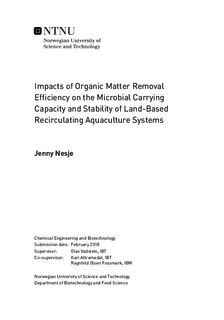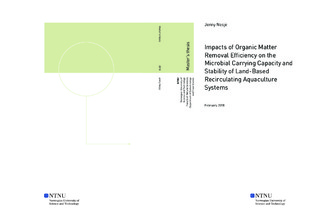| dc.description.abstract | Accumulation of organic matter and particles generated from uneaten feed and faeces is one of the major challenges in recirculating aquaculture systems (RAS), in particular colloidal and dissolved fractions as these serve as bacterial substrate. Particles can potentially cause damage on the gills of the reared species and may reduce their resistance to pathogens. Most diseases in aquaculture of marine fish are caused by opportunistic bacteria which become pathogenic when the fish is under stressful conditions. In the present study, the consequences of different levels of organic matter removal on physicochemical and microbial water quality were investigated in replicate small-scaled RAS for production of Atlantic salmon parr (Salmo salar). Two RAS were run in parallel over 140 days, including one conventional system (cRAS) and one system with an implemented membrane (mRAS). In mRAS, a side-stream of 10% of the water flow was filtered through an ultrafiltration (UF) membrane prior to the bioreactor. Furthermore, the potential of the novel method for particle and bacteria monitoring GRUNDFOS BACMON was investigated by comparing with several other counting methods employed in this study, including bacteria counting with flow cytometry, counting of colony-forming units (CFU), and particle counting with a Coulter counter.
The present study demonstrated significantly lower numbers of bacteria and particles in mRAS compared to cRAS. Furthermore, the concentrations in mRAS were more stable with fewer and smaller fluctuations, and adapted to environmental changes faster than the concentrations in cRAS. No significant difference in fish survival, weight or health were observed between the systems. The results demonstrated that implementation of a UF membrane in RAS efficiently reduced the bacterial carrying capacity (CC) by removing organic matter and bacteria. Comparison of different counting methods indicated that BACMON is applicable in monitoring the temporal variations through the experiment on a daily and weekly basis, but the numbers of bacteria and particles were too high to detect correct total counts. | |

